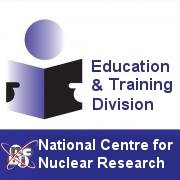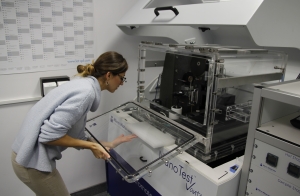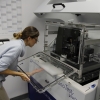A promising candidate for material for extreme tasks
2023.03.22 16:52 - Marek PawłowskiThe search for materials that retain high mechanical parameters in the environment of the interior of high-temperature nuclear reactors is an extremely difficult task. The latest research by scientists from the nuclear center in Świerk suggests that the material capable of withstanding such extreme working conditions may be hidden among alloys whose basic components are nickel and iron.
Intense and prolonged neutron bombardment, high temperature and high pressure create an environment extremely hostile to any material. No wonder that in the work on the construction of the latest, fourth generation nuclear reactors, the main emphasis is on the search for materials capable of maintaining high mechanical parameters in such unfavorable conditions. A promising candidate for material for „special tasks” has recently been indicated by a team of scientists from the National Center for Nuclear Research (NCBJ) in Świerk, led by prof. PhD Łukasz Kurpaska.
High Temperature Reactors (HTRs) are considered an important element of nuclear energy. On the one hand, they are simply safe, because the appropriate design, operating parameters and fuel selection guarantee that a possible uncontrolled increase in temperature, instead of driving the chain reaction, will lead to its self-extinguishment. On the other hand, these reactors can perfectly meet the needs of modern industry, as they are able to supply steam with a temperature of 500 degrees Celsius or higher, which allows it to be used as a source of process heat in the chemical industry and even for the production of hydrogen. The problem, however, is to find materials capable of meeting the requirements imposed by the specificity of the operation of HTR reactors.
„In recent years, a lot of attention has been paid to high-entropy alloys, formed from at least five components of similar concentration, often with similar atomic mass. These materials have unique properties, including they are characterized by high yield strength, hardness at high temperature and very good resistance to radiation. By modifying their chemical composition, you can easily improve the desired properties, for example to increase strength or ductility,” says MSc. Eng. Edyta Wyszkowska (NCBJ), the first author of the article on radiation damage in nickel-iron alloys, which was recently published in the prestigious scientific journal „Nanoscale”.
Physicists from the National Center for Nuclear Research are primarily interested in understanding the fundamental phenomena occurring inside materials exposed to radiation and in determining the initial chemical composition around which further research can be conducted. For this reason, they focused their attention on the alloys of only two metals: nickel with iron. The decision was well thought out. Both nickel and iron are common components of high-entropy alloys, so understanding the mechanisms responsible for the unique properties of the nickel-iron system would create a solid foundation for further searches for alloys with even better parameters.
The reported studies used nickel-iron single crystals produced at the National Center for Nuclear Research using the Bridgman-Stockbarger method (the single crystal grows around the nucleus deposited at the bottom of the melting crucible). Four alloys with increasing iron content were used for the study: 12%, 23%, 38% and 62%. In order to produce radiation damage identical to that resulting from the impact of the neutron stream, properly prepared samples of materials were placed in the ion implanter and subjected to the impact of the ion stream. „By bombarding with ions instead of neutrons, the modified materials are non-radioactive and can be safely analyzed in the laboratory. What is very important, however, is that this technique enables quick and precise material defects. In just a few Within a dozen or so hours, radiation damage can be produced in the outer layer of the material to a depth of even a micrometer, which corresponds to the damage formed over several dozen years of reactor operation,” explains MSc Eng. Wyszkowska.
The analyzes and simulations carried out in Świerk reveal an interesting picture of changes in nickel-iron alloys under the influence of radiation. Studies have shown that the highest hardness is shown by the alloy with the addition of 38% iron, but the greatest resistance to the formation of radiation defects was observed for the alloy containing the largest amount of iron, i. e. 62%. Moreover, defects in the latter alloy were uniformly distributed within the ion-modified layer, while in the other alloys they clustered near a certain depth. This is an important feature because clustering of defects is a dangerous phenomenon, potentially leading to delamination of the material.
According to the physicists from the National Center for Nuclear Research, the increase in the radiation resistance of nickel alloys with the increase in the iron content can be explained by differences in the electron configuration of the atoms of both elements. They cause that iron atoms excited by radiation retain their position in the crystal lattice more easily than excited nickel atoms. In the light of the analyzes carried out so far, the nickel alloy with 62% iron content seems to be a promising candidate for the construction material of the fourth generation nuclear reactors and may be the basis for further research. Before it goes into the hands of engineers, further studies of its properties, especially at high temperatures, will have to be carried out, as well as many years of testing in a real reactor operating environment. However, the knowledge gained by NCBJ scientists will be applicable today, as it will optimize further search for multicomponent alloys with potentially even better mechanical parameters and high radiation resistance.
Work on NixFe1-x alloys is carried out as part of the project NOMATEN Center of Excellence, financed by grants from the Foundation for Polish Science, the European Commission and the National Science Centre.
SCIENCE PUBLICATIONS:
„Tuning heterogeneous ion-radiation damage by composition in NixFe1−x binary single crystals” E. Wyszkowska, C. Mieszczyński, Ł. Kurpaska, A. Azarov, I. Jóźwik, A. Kosińska, W. Chromiński, R. Diduszko, WY Huo, I. Cieślik, J. Jagielski
Nanoscale 15, 4870-4881, 2023 DOI: https: //doi. org/10.1039/D2NR06178C
ILLUSTRATION:
Preparations for nanomechanical tests after ion implantation using the NanoTest Vantage device at the National Center for Nuclear Research in Świerk. (Source: NCBJ)


















